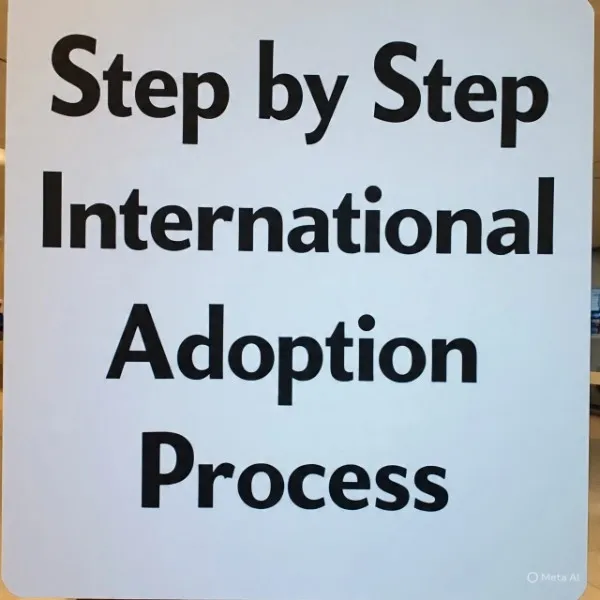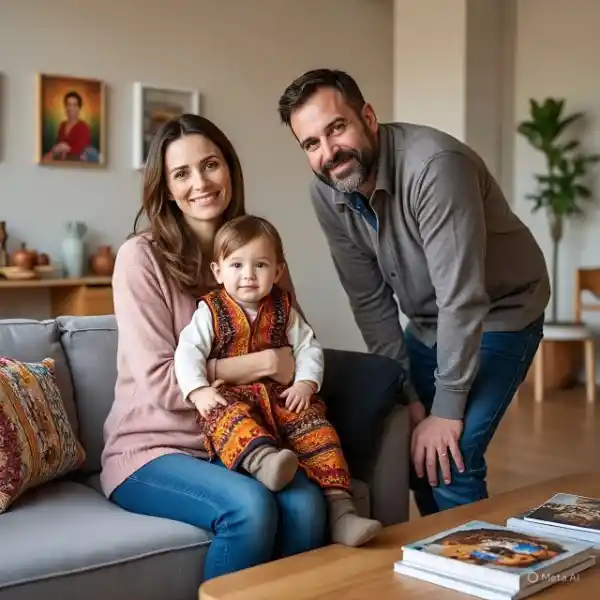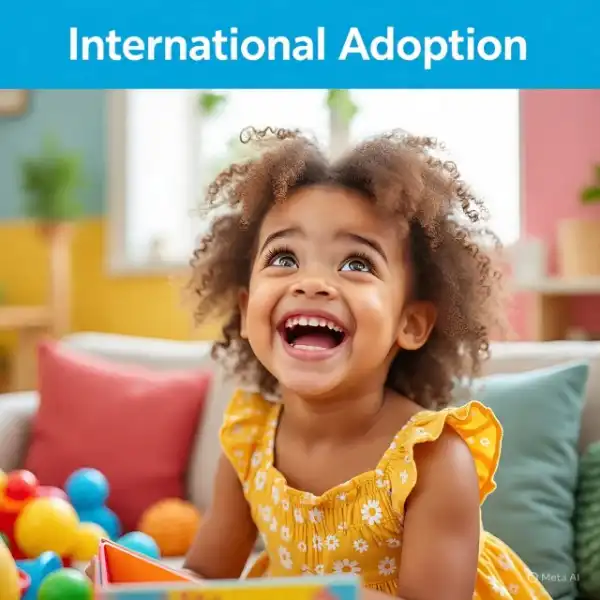Guaranteed International Adoption Process Step-by-Step You Need

Is it possible to navigate international Adoption without making costly mistakes that can delay your family dreams? Yes, it’s possible.
Every year, thousands, if not millions, of prospective families begin their journey on international adoption, only to find themselves lost in the sea of paperwork, legal requirements, and emotional rollercoaster.
The dream of bringing a child from another country into your home is interesting, but there are many hurdles along the way. It involves navigating complex foreign regulations, immigration laws, and many bureaucratic challenges.
But what if you could approach this interesting process with confidence, a clear prototype that eliminates guesswork and prevents costly mistakes?
Understanding the international adoption process step-by-step will not just help you have an easy international adoption journey, but will also show you how to easily and quickly navigate the legal and hardest aspects of international adoption.
This comprehensive guide will walk you through every critical stage of international adoption, and ensure that you are fully prepared for the journey ahead.
Here’s What You’ll Learn From This Post:
- The complete international adoption process, step-by-step, from the very first step of research to the last step of bringing your child home.
- Critical documentation requirements and how to prepare them correctly the first time.
- Home study preparation strategies that have helped thousands adapt to hitches.
- Country-specific requirements and how to choose the adoption that is right for you.
- Immigration and visa procedures for your adopted child.
- Post-adoption obligations and support resources.
- The most common challenges you may likely face in your international adoption journey, and how to avoid them to eliminate delays and additional costs.
- Expert insights from top adoption professionals with many years of experience.
- Realistic timelines and all the expected costs for international adoption.
- How to maintain emotional resilience throughout the adoption journey.
Understanding the International Adoption Process:
Before we dive into the international adoption process step-by-step, we must get ourselves acquainted with the current landscape of this type of adoption.
The Hague Adoption Convention, created in 1993, is the main regulation for adoptions between member countries. Its main purpose is to safeguard the interests of children, birth families, and adoptive families.
This pact guarantees the observance of ethical standards in the adoption field and lays down the guidelines for the procedures. More than 100 countries, alongside the United States, are parties to this agreement.
If you decide to adopt from a country that is a member of the Hague Convention, then particular measures and steps must be followed. Some countries are not part of this convention, which means that different rules apply to adoptions in those countries.
Knowing whether the location you have selected is from the Hague or non-Hague countries will fundamentally influence your adoption journey as well as which agencies you are allowed to work with and the legal process that you have to follow.
Phase One: Preparation and Decision-Making:
The first phase of the international adoption process, step-by-step, is in the preparation stage which takes place long before any paperwork submission. The preparation part is filled with the most important decisions that will impact your entire adoption experience.
First of all, investigate countries that have an active adoption program with the country you live in. Consider the following aspects: age, marital status, religion, and whether the country in question is willing to accept single parents.
Each of the countries has its own unique requirements when it comes to international adoption step-by-step, which you have to comply with.
Besides that, try to gather information on the average age of children who are up for adoption, how long one has to wait, and what the requirements and costs associated with the trip are.
Some countries may require you to make multiple trips, while in others, you can complete the international adoption process in a single visit.
Build a family with the help of a structure that will guide you through the different countries based on your family’s circumstances, preferences, and possibilities.
Generally, this stage of research takes from two to three months; however, this is the very stage where the foundation for everything that you will experience later in your international adoption process path is laid down.
Phase Two: Choosing an Accredited Adoption Agency:

Another important step to take before starting your journey, as covered in this international adoption process step-by-step is to search and choose the best adoption agency.
For Hague Convention adoptions, you must choose an agency approved by the U.S Department of State and accredited by the Council on Accreditation. These are the agencies that have demonstrated their capabilities to meet strict ethical and professional standards.
When searching for the agency to work with, examine their experience with your choice countries of adoption, their success rate, and mostly their support services.
Ask your family members and friends who have recently completed the international adoption process through the agency process for references.
Ensure to understand their feelings structure completely, including other services they cover, and additional costs you might envisage.
A good adoption agency will provide you with pre-adoption education to help you navigate paperwork, and they can work with foreign partners to offer Post-Adoption support.
The best is that they will be there to guide you through the complexities of the international adoption process ahead. The right agency partnership can make the difference between a smooth international adoption process and a frustrating experience filled with preventable obstacles.
Phase Three: Wrangling the Home Study:
Alright, so here’s where stuff gets real. The home study isn’t just paperwork, but a giant magnifying glass on your whole life. A social worker (think: friendly detective) will want to get some information concerning your past, your finances, your health, and every corner of your house.
They’ll ask you questions about your childhood, your relationships, how you plan to parent, and what’s really motivating you here. They will also check if your house is safe and if you’ve got enough space.
There’s also a bunch of adoption training that usually lasts at least 10 hours, where you learn about everything from trauma and attachment to special needs and cultural stuff. This whole thing can drag out for three to six months.
Pro tip: Start gathering the important documents early and fix up any safety issues in your home before anyone shows up with a clipboard. When it’s all done, your shiny stack of approvals is your golden ticket for immigration and all those foreign officials.
Phase Four: Dossier Time (a.k.a. Paperwork Olympics)
Once the home study’s done, it’s dossier season. Basically, you’re putting together a mountain of documents to prove you’re not a criminal, you have a job, and you’re not living in a treehouse.
Birth certificate, marriage licenses, divorce papers, financial statements, employment letters, medical stuff, police checks, passport copies, and others And every single page probably needs to be notarized, certified, and then “apostilled” (don’t ask, just Google it).
Most countries want it all translated, too. Your agency will hand you a checklist longer than a CVS receipt, but you’ll want to make your own tracker because a bunch of these docs expire in a few months.
Give yourself three to six months, honestly. This packet is literally what foreign officials will judge you on during your international adoption process, so double-check every detail. No pressure.
Phase Five: The Epic Wait
Now, you ship that dossier off and…wait. This is the “refresh your email until your eyes cross” phase. How long? It could be a few months. It could be years. Depends on the country and a whole bunch of stuff you can’t control.
Some places love to send updates. Some don’t even remember your name until something’s happening. Best thing you can do: keep learning, keep prepping your house, keep your support squad close, and keep your finances in order.
Lack of understanding will drive you a little nuts. Stay in touch with your agency and connect with other friends that has gone through the international adoption process before now.
When you finally get a referral (with photos, medical files, and a deadline), it’s decision time. Most folks call in an international adoption doc to decode the medical jargon. Don’t rush, because this is huge.
Phase Six: “Yes!” and Getting Ready to Jet:
Once you say yes, everything speeds up. There are forms to file—either I-800 or I-600, depending on whether the country is in “The Hague Club.” (Basically, more paperwork.) USCIS gets involved, and they’ll let the U.S. embassy or consulate know you’re coming.
Meanwhile, you’ll be dealing with the other country’s legal maze—maybe court hearings, maybe a foster care waiting period, maybe both.
Start looking at flights, visas, hotels, and how much time you’ll need off work (it’s often weeks, not days). Get your kiddo’s stuff ready. Oh, and brace yourself—this is just the warm-up for the real feels.
Phase Seven: In-Country Rollercoaster:
Now you’re finally traveling. Meeting your child? Nothing prepares you for that. It’s wild, sometimes awkward, sometimes magical, sometimes just plain overwhelming.
The agency’s local partners help you shuffle between offices, courtrooms, and government buildings. Some kids warm up right away. Others need time—especially if they’ve been through the wringer. Listen to the caregivers; they know what works.
Depending on the country, you might finish the international adoption process there or just get custody and finish in the U.S.
You’ll head to the U.S. embassy for a visa interview—sometimes it’s quick, sometimes you wait for days. Schedules change. Roll with it. And hey, try to soak up the local scene—your kid’s birth culture is part of their story now.
Phase Eight: Welcome Home, Chaos:

Coming home feels unreal. Your kid lands with an immigrant visa and, if you did the full adoption overseas, they’re a U.S. citizen the second you touch down. If not, there’s a court date ahead to wrap things up here.
Apply right away for their citizenship certificate and passport’ll need both sooner than you think. The first weeks are a blur. Your child’s trying to figure out your weird food, your language, your routines, and honestly, you.
There might be tears, tantrums, or total silence. It’s normal. Give it time. You’re all figuring it out together.
Phase Nine: Post-adoption Needs And Assistance:
The international adoption process, step-by-step, does not end when you arrive with your child. Most nations ask post-adoption reports on your child’s adaptation and growth.
Usually created by your home study social worker, these reports are periodically delivered and frequently at 6 months, 12 months, and occasionally longer, even to the adoption authorities of the foreign nation.
Not finishing these reports could endanger future adoptions from that country and break deals you negotiated during your adoption. Beyond the legal obligations, prioritize your child’s emotional and physical health.
For thorough health checks, set appointments with a pediatrician knowledgeable about international adoption medicine. Many youngsters have developmental impairments or unidentified medical diseases needing therapy.
Connect with psychologists who grasp adoption-related concerns as well as attachment and trauma. Through language classes, cultural activities, heritage camps, and talks on their adoption story, please help your child stay connected to their birth culture.
Connect with local adoptive family networks where your child might meet other internationally adopted children and you could get continuing support and resources.
Expert Insight #1: International Adoption Medicine Specialist Dr. Sarah Mitchell:
“Through 20 years working with children adopted from abroad, I have come to realize that knowing the international adoption process step-by-step must go beyond merely documents and legal obligations.
Families must get ready for the medical and developmental facts that many adopted children are confronted with. Many kids ready for foreign adoption have been malnourished, exposed to alcohol or drugs before birth, without enough medical treatment, in institutional care, or in trauma.
Development and health are really impacted by these experiences. Consult experts who can go over available medical records and assist you in understanding what ailments could be present beyond what is documented before accepting a referral.
Comprehensive medical screening is imperative not only for infectious illnesses but also for sight, hearing, oral health, growth, development, and mental health once you get your child home. Early identification of several diseases makes them treatable.
I too point out that not everything can be cured by love. Adopted children sometimes need tailored help including speech therapy, occupational therapy, trauma-informed therapy, and educational interventions.
Emotionally and financially getting ready for these possible requirements enables families to give their kids the best care possible.
Interactive Adoption Readiness Assessment:
These step-by-step tips for the international adoption process will help you gauge your readiness for the international adoption journey. Take into account these essential readiness factors.
Initially, judge your motivation; are you adopting internationally due to infertility, wanting to aid children, being linked to a particular culture, or other reasons? Comprehending your motivation will help you get emotionally ready.
Then, appraise your support system, do you have a family, friends, and community members who agree with your decision of adoption and will give you both practical and emotional support?
Next, scrutinize your monetary readiness, are you saving enough money to pay for adoption costs and also have reserves for unexpected expenditures and post-adoption needs?
Subsequently, think of your adaptability, will you be able to manage uncertainty, fluctuating timelines, and unanticipated events with the same calm and enthusiasm?
Then, evaluate your cultural competency, do you have the willingness and ability to help your child keep in contact with his/her birth culture, study his/her background, and encourage him/her to keep the culture going?
Furthermore, examine your parenting preparedness, have you researched trauma, attachment, developmental delays, and adoption-specific parenting successfully?
Next, assess the power of your relationship through the stability factor. If you have a partner, are you and your partner on the same page regarding the decision of adoption, and mentally and emotionally prepared for the stress the international adoption process might cause?
The honest responses to these questions put on the table not only the qualities that you already have, but also those areas that need some nurturing before you can start the formal adoption process.
Financial Planning for International Adoption:
The international adoption process, step-by-step, with financial aspects clearly laid out, helps you prepare well and thus avoid surprises.
Common fees related to the adoption are agency application fees ($200-$500), home study ($1,000-$3,000), dossier preparation including document fees, notarization, and authentication ($1,000-$2,500).
There’s also agency program fees($15,000-$30,000), foreign country fees ($3,000-$8,000), immigration fees ($775-$1,000), travel expenses including flights, accommodation, and meals ($3,000-$10,000), post-adoption reports ($500-$1,500), and legal fees if applicable ($1,000-$3,000).
Total costs usually range from $30,000 to $50,000 depending on the country and your particular case.
Look into various financial resources such as the Federal Adoption Tax Credit (up to $16,810 for 2025), employer adoption benefits (more than 80% of the companies offer $5,000-$20,000), adoption grants from organizations like the Gift of Adoption Fund or Show Hope, adoption loans with attractive interest rates, fundraisers using platforms such as AdoptTogether, and military benefits for service members.
Make a budget that is as detailed as you can, keep a very close watch on your spending, and make sure that you also set aside some money to meet any urgent cases. If you plan financially, you will be less stressed and you will be able to concentrate on the emotional side of adoption.
Conclusion: Your Path Forward in International Adoption:
The international adoption process, step-by-step, is a multifaceted, drawn-out, and emotionally testing trek that in the end, results in one of the very deepest and most meaningful experiences of life – the integration of a new family member, a child.
With the guide, you’ve covered the nine essential stages from the first research phase to meeting post-adoption requirements along with the paperwork and the legal processes, budgeting needed, and the emotional prep work.
You have learned the advice of experts who stress the necessity of cooperating with the right professionals, being prepared for the medical and developmental status of the child, and holding the right expectations.
You are aware of the usual problems and the ways to solve them. What is equally important, you see that international adoption is not just a matter of completing paperwork and following procedures, but it is a huge step in preparing to take care of a child who has been lost, might have been abused, and has experienced a lot of life changes.
Step-by-step, the international adoption process is a test of the parents’ patience, adjustability, financial means, emotional strength, and most of all, their devotedness.
The slowdowns that result in the delay of documents will become frustrating, waiting times will bring anxious moments, and when difficulties occur, you will find yourself doubting.
On the other hand, the memory of going through the photo of your child for the first time will be there forever among the moments of happiness and when you finally meet your child face to face, the overwhelming joy will come.
And lastly, the feeling of great fulfillment by extending your family beyond the borders and crossing different cultures will be there.
Every year, thousands of families go through the international adoption process successfully, and so with the right preparation, honest partnerships, and a strong enough support system, you too can do it.
Frequently Asked Questions On The International Adoption Process:
Q: From start to end, how long does the stepwise process of international adoption really take?
The timeline for the international adoption process varies greatly depending on the country program, child traits you’re willing to accept, and how fast you finish the necessary procedures. Families should anticipate from 1.5 to four years on average from starting their home study to bringing their child home. While other nations have wait times of more than three years, some have shorter 12–18 month timelines. Three to six months of home study fulfillment; two to four months of dossier preparation; six months to three plus years of referral waiting; immigration procedure (2-4 months); and in-country standards for 1-6 weeks. Being adaptable about kid traits, selecting nations with shorter wait times, meticulously preparing paperwork to prevent revisions, and responding promptly to agency demands are among the elements that accelerate the process. Asking for certain characteristics like infant girls, having document problems needing changes, country program suspensions or delays, immigration delays, and factors that extend schedules are among them. Rather than worrying about future estimates, concentrate on finishing every stage precisely and sustaining emotional toughness throughout waiting times.
Q: What qualifications and requirements are most critical for international adoption?
From several sources, including U.S. federal legislation, your state’s adoption rules, and the demands of the international adoption process requirements for global adoption. Adoptive parents must be at least 25 years old under U.S. immigration legislation, married couples must adopt jointly, and families must have the financial means to care for a child. Every state has particular requirements for age, marriage status, and home study criteria. Foreign nations establish their own requirements, which differ greatly: some accept only married heterosexual couples, others accept single women, some have religious restrictions, and many have requirements or age constraints on the gap between parents and children. Common requirements are a stable income showing capacity to support a child, appropriate housing with space for the child, mental and physical health, completion of adoption education, clearances, and background checks revealing no child abuse or major criminal history. Some countries give adoptive families already with biological or adopted children preference; others give parenting experience top priority. Review the particular demands for the nations you’re thinking about before pouring money and time into the procedure so you can guarantee your eligibility.
Q: Are the age, gender, and other attributes of the child determined by me when I adopt internationally?
satisfy the wishes of the adoptive parents. Parents should sort through what needs they can handle and what support networks they can turn to and then be as flexible as possible within those reasonable parameters. A great many families will tell you that their adopted child is very different from who they first thought of, and they wouldn’t trade their family for anything.



